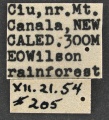New Caledonian Ants
New Caledonia, while relatively small, has a rich ant fauna with a relatively high proportion of endemic species (greater than 80%). See the checklist of described species and Ant Diversity of New Caledonia for a list of all species, described as well as undescribed, along with images. This island is undercollected and the number of endemic species is expected to increase.
Overview
New Caledonia is an archipelago located in the Western Pacific Ocean, 1,500 kilometres (930 mi) east of Australia and about 20,000 kilometres (12,000 mi) from Metropolitan France. The archipelago includes Grande Terre, the Loyalty Islands, the Belep archipelago, the Isle of Pines and a few remote islets. Noumea is the capital and the only sizeable city.
New Caledonia is part of Zealandia, a fragment of the ancient Gondwana super-continent. Zealandia separated from Australia 60–85 million years ago. New Caledonia itself separated from Australia 65 million years ago, subsequently drifting in a north-easterly direction, reaching its present position about 50 million years ago.
The mainland is divided in length by a central mountain range whose highest peak are Mount Panié (1629 m) in the north and Mount Humboldt (1618 m) in the southeast. The east coast is covered by a lush vegetation. The west coast, with its large savannahs and plains suitable for farming, is a drier area. Many ore-rich massifs are found along this coast.
The Diahot River is the longest river of New Caledonia, flowing for some 100 kilometres (62 mi). It has a catchment area of 620 square kilometres and opens north-westward into the Baie d'Harcourt, flowing towards the northern point of the island along the western escarpment of the Mount Panié. Most of the island is covered by wet evergreen forests, while savannahs dominate the lower elevations. The New Caledonian lagoon, with a total area of 24,000 square kilometers is one of the largest lagoons in the world. It is surrounded by the New Caledonia Barrier Reef.
The climate is tropical, with hot and humid period from November to March with temperatures between 27°C and 30°C,and a cooler, dry period from June to August with temperatures between 20°C and 23°C, linked by two short transition periods. The tropical climate is strongly moderated by the oceanic influence and the trade winds that reduces humidity, which can be close to 80%. The average annual temperature is 23°C, with historical extremes of 2.3°C and 39.1°C.
The rainfall records show that precipitations differ greatly within the island. The 3000 mm of rainfall recorded in Galarino are three times the average of the west coast. There are also dry periods, because of the effects of El Nino.Between December and April, tropical depressions and cyclones can cause winds to exceed a speed of 100 km/h with gusts of 250 km/h and very abundant rainfall.
New Caledonia has many unique plants and animals, especially birds. It has the richest diversity in the world per square kilometre. The biodiversity is caused by Grande Terre's central mountain range, which has created a variety of niches, landforms and micro-climates where endemic species thrive.
Flora
Typical terrain in the south of the islands at Grand TerreWith 44 species in five generas, New Caledonia is the tropical country with the highest concentration of Gymnosperms. Of the 44 species of gymnosperms, 43 are endemic, including the only known parasite Gymnosperm (Falcatifolium taxoides). It is one of five regions the world in which the Nothofagus still exists, with five species.
Shrubby vegetation (maquis minier) occurs on metalliferous soils, mostly in the south. The soils of ultramafic rocks (mining terrains) have been a refuge for many native flora species because they are toxic and inadequately mineralized for most foreign species.
Of the 35 araucaria tree species recorded worldwide, 13 are endemic to New Caledonia. The largest fern of New Caledonia is the Cyathea intermedia, it can reach 30 m and is the largest known on earth. Cyathea intermedia is endemic but very common on acid ground, it grows at a speed of 1 m per year on the east coast, usually in the fallow or forest openings. There are also Cyathea novae-caledoniae.
Fauna
The endemic Kagu birdNew Caledonia is home to the New Caledonian crow, a bird noted for its tool-making abilities, which rival that of primates.These crows are renowned for their extraordinary intelligence and ability to fashion tools to solve problems, and make the most complex tools of any animal yet studied apart from humans.The endemic Kagu, agile and able to run fast, is a flightless bird, but it is able to use its wings to climb branches or glide. It is the surviving member of monotypic family Rhynochetidae, order Gruiformes.
Several species of New Caledonia are remarkable for their size: the Ducula goliath is the largest pigeon in the world; Rhacodactylus leachianus, the largest gecko in the world; the Phoboscincus bocourti the largest skink in the world, thought to be extinct but rediscovered in 2003." (Wikipedia 2011).
Monomorium species 1
Monomorium species 2
Cerapachys species 1
Crematogaster near emeryi
Vollenhovia species 1























